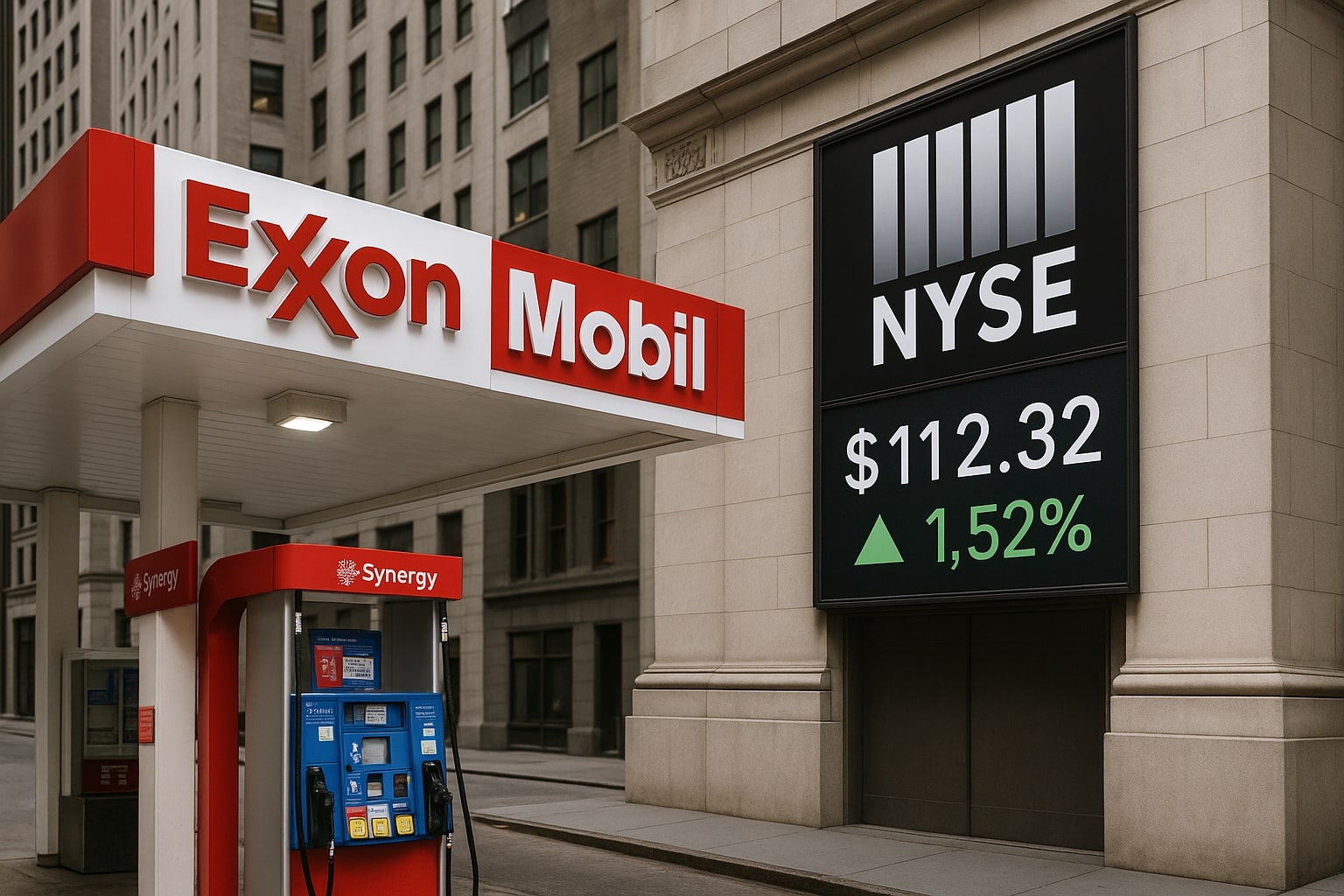
Exxon Mobil Stock Price Climbs Above $112 as Guyana Oil and LNG Growth Power 2026 Recovery
uyana’s record output, $750B EU trade deal, and LNG expansion position Exxon Mobil for EPS growth toward $7.62 and price targets up to $147 as natural gas demand rises into winter | That's TradingNEWS
Exxon Mobil (NYSE:XOM) Surges Above $112 as Guyana Output and LNG Expansion Reinforce Global Growth Outlook
Exxon Mobil (NYSE:XOM) advanced to $112.38, up 1.57%, supported by renewed optimism over Guyana’s record oil production, LNG expansion, and rising natural gas demand ahead of winter. With a market capitalization of $479.08 billion, P/E ratio of 15.93, and a dividend yield of 3.52%, Exxon maintains a strong position among global energy leaders. Despite a 12.34% decline in Q2 2025 revenue to $80.04 billion and net income down 23.35% to $7.08 billion, the company’s diversified portfolio and disciplined capital strategy continue to provide resilience amid oil market volatility.
Guyana: The Backbone of Exxon Mobil’s Growth Strategy
Guyana’s offshore production remains the central pillar of Exxon’s future earnings expansion. The company’s recent sale of 4 million barrels of Guyanese crude oil to Indian Oil Corp. and Hindustan Petroleum Corp. marked India’s first purchase of this crude grade, solidifying Exxon’s growing footprint in Asia. Production in the Stabroek Block—driven by the Yellowtail development—has reached 900,000 barrels per day, with plans to nearly double to 1.7 million barrels per day by 2030 across eight new developments.
The Hammerhead project, greenlit in September 2025, is projected to produce 150,000 barrels per day by 2029. Meanwhile, construction continues at Uaru and Whiptail, expected online in 2026 and 2027 respectively. These fields offer long-duration, low-cost production, giving Exxon operational stability even if Brent crude remains capped near $60–$65 per barrel.
Natural Gas: The Quiet Catalyst Behind Exxon’s Winter Play
As winter approaches, Exxon Mobil’s natural gas operations are emerging as a crucial earnings driver. With Henry Hub prices near $3.32 per MBTU, roughly 10% below the five-year average, any temperature-driven surge in demand could significantly impact profits. U.S. storage levels remain only 4.5% above historical averages, leaving limited buffer as colder conditions develop.
Exxon’s 8.7 billion cubic feet per day production capacity translates to an EPS sensitivity of roughly $0.08 per $0.10 increase in gas prices. Should prices reach $4.50–$5.00 per MBTU, EPS could climb close to $1.90 per share in early 2026, up from the Q2 figure of $1.64. This could elevate near-term valuations as the company benefits from both its upstream leverage and its growing LNG network.
Permian Basin Expansion Secures Long-Term Cash Flow
Exxon Mobil’s Permian Basin operations are among its most consistent growth engines. Output has reached 1.6 million barrels of oil equivalent per day (boe/d), and management targets 2.3 million boe/d by 2030. Technological improvements such as longer well laterals and enhanced recovery methods have increased well productivity by 20%, adding 18 billion boe to the company’s reserves.
Complementing this domestic strength is the Golden Pass LNG terminal in Texas, expected to begin exports in early 2026. The facility will process 18 million tons per annum (MTPA), with Exxon marketing 30% of volumes. This dual exposure—steady Permian output and rising LNG throughput—positions Exxon to capitalize on global demand shifts toward cleaner energy.
Diversification into Synthetic Graphite and Proxxima Strengthens Non-Oil Earnings
Exxon Mobil’s expansion beyond hydrocarbons signals a long-term strategic pivot. The acquisition of Superior Graphite’s U.S. assets places the company at the forefront of synthetic graphite production for EV batteries. By converting refinery feedstock into graphite, Exxon bypasses traditional mining, reducing energy costs and environmental impact.
At the same time, the Proxxima materials system—a high-performance resin for infrastructure and automotive applications—is moving toward commercialization. Phase 1 of the Texas blending facility nears completion, supported by a supply agreement with a Middle Eastern construction firm. Exxon projects $3 billion in additional earnings by 2026, scaling to $20 billion by 2030, as these innovations drive a new segment of industrial revenue.
Read More
-
VOO ETF Hits $630 as Fed Shift and AI Growth Power 2026 Rally Toward $700
07.12.2025 · TradingNEWS ArchiveStocks
-
XRP ETFs XRPI & XRPR Aim for $1B Inflows as XRP Holds $2.02 Support
07.12.2025 · TradingNEWS ArchiveCrypto
-
Natural Gas Price (NG=F) Rallies to $5.29, Freezing Temperatures Spark Bullish Breakout
07.12.2025 · TradingNEWS ArchiveCommodities
-
USD/JPY Price Forecast - Dollar Extends Slide to 154 as BoJ Hawkish Pivot Drive Yen Toward 150
07.12.2025 · TradingNEWS ArchiveForex
Financial Health and Capital Allocation Remain Pillars of Stability
Exxon Mobil’s financial position underscores its strength. The company ended Q2 2025 with $15.7 billion in cash and equivalents and $39 billion in total debt, maintaining a conservative 0.33x net debt-to-EBITDA ratio. Share repurchases totaled $9.8 billion in the first half of 2025, reinforcing shareholder value alongside its reliable dividend.
The quarterly dividend of $0.99—or $3.96 annually—reflects a yield of 3.52%, placing Exxon among the top income producers in the sector. Despite declining revenue, the company’s operating expenses of $15.23 billion remained tightly controlled, allowing for a net profit margin of 8.85%. With a P/E ratio of 15.93, the stock remains attractively valued relative to peers, and its dividend spread above the sector average highlights its defensive appeal.
Trade Agreements, LNG Exports, and Strategic Partnerships Drive Global Reach
Exxon’s growth trajectory extends beyond the Americas. The recent trade agreement with the European Union, committing $750 billion in U.S. energy imports by 2028, reinforces demand for Exxon’s LNG exports. Meanwhile, new frameworks with Japan include LNG offtake projects and investments in advanced fuels—directly benefiting Exxon’s refining and gas divisions.
The company’s participation in Brazil’s Bacalhau field, alongside Equinor and Petrogal Brasil, marks a key milestone in deepwater expansion. This project diversifies Exxon’s production portfolio while maintaining exposure to regions with high-margin output potential.
Valuation, EPS Outlook, and Investment Decision
At $112.38 per share, Exxon Mobil trades below its historical fair multiple. Using a forward EV/EBITDA of 7.3x versus a target multiple of 7.83x, intrinsic valuation models suggest upside potential toward $147 per share. FY2026 earnings estimates of $7.62 per share imply a 12.5% increase year-over-year, supported by LNG and natural gas-driven profitability.
If gas prices approach $5.00 per MBTU, EPS could expand by $0.80–$1.00, placing the short-term price target in the $130–$135 range. With a secure dividend, solid balance sheet, and strong upstream pipeline, Exxon offers both income and growth stability within a volatile energy landscape.
Verdict: Buy — Structural Upside with Strong Energy Transition Momentum
Exxon Mobil’s diversified portfolio, disciplined capital structure, and long-term visibility position it as a Buy heading into 2026. The company’s combination of traditional energy strength—anchored by Guyana and Permian Basin production—and forward-looking investments in LNG and synthetic graphite underscores a balanced transition strategy.
With projected EPS recovery, sustained dividend growth, and global project execution, Exxon Mobil (NYSE:XOM) remains one of the most compelling large-cap energy holdings for both stability and upside.


















